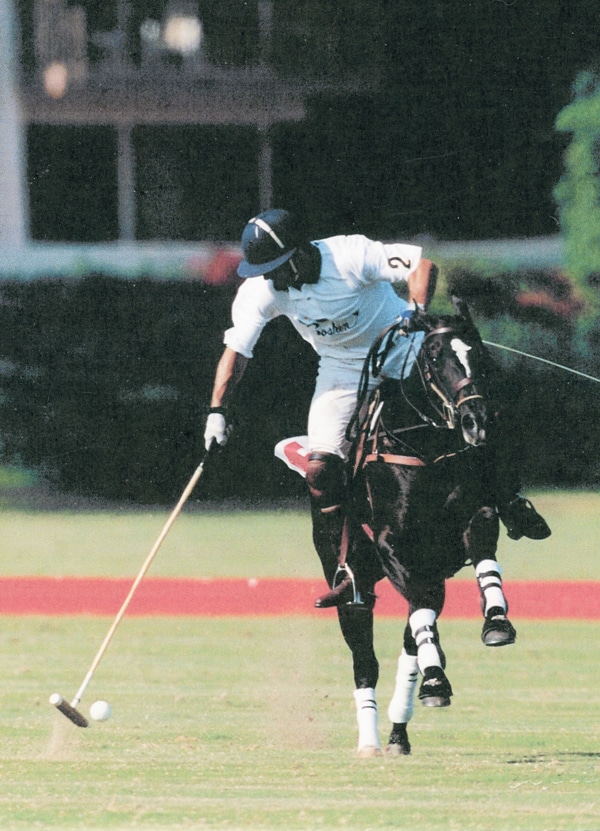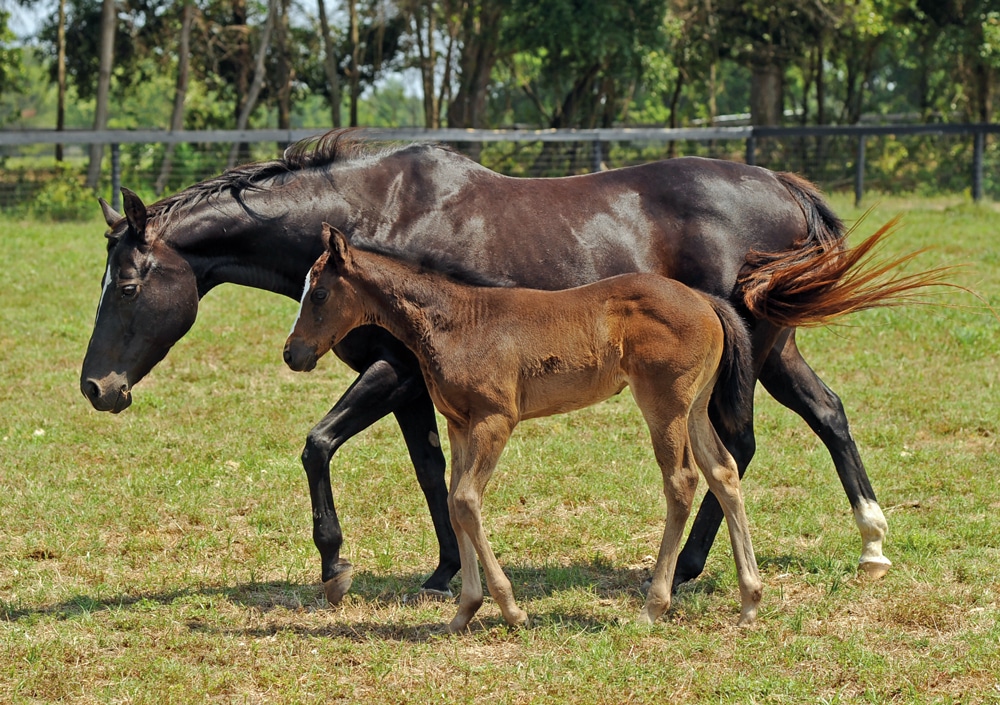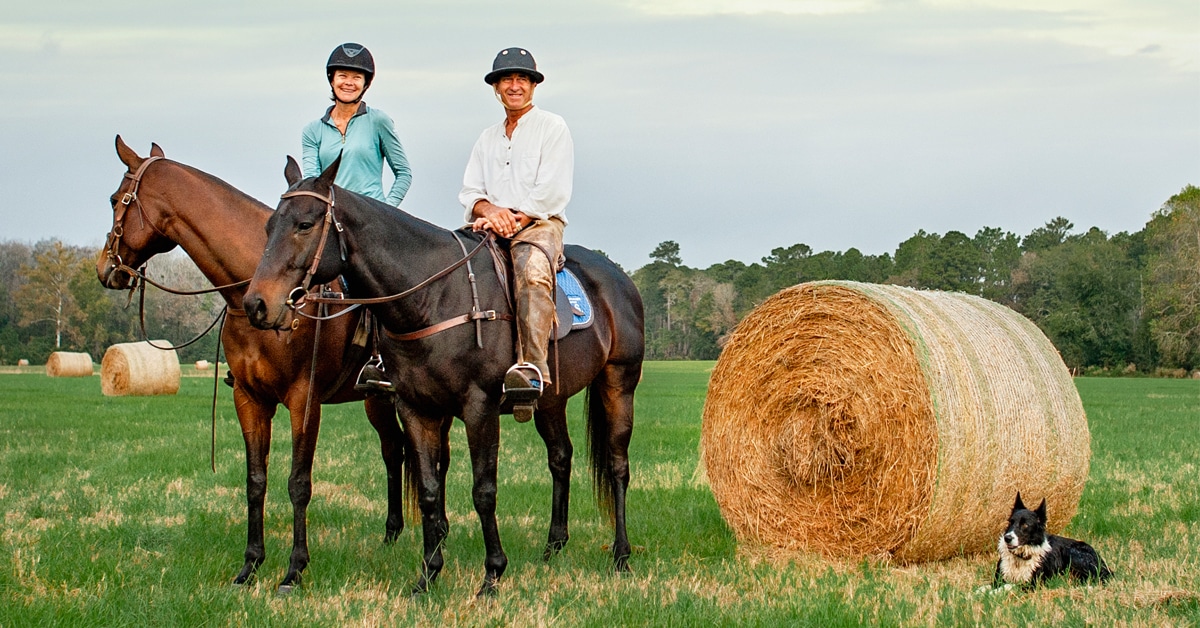Writing these pages, I find myself sometimes distinguishing between a favorite horse and a best horse. This separation seems counterintuitive—wouldn’t they be one and the same? But, in fact, it is not.
Recently someone asked me to name the best horses I had ever played. This was easy. Though I have competed scores of world-class ponies, there are three that were truly different: Pumbaa would be my first choice to play in a sudden-death chukka for my life. Amy was the most complete mare I had ever played. And Hale Bopp was my favorite.

And she accumulated six BPP prizes during her career to prove it: All of these were in high-goal tournaments at the 20-, 22-, and 26-goal levels.
How did she play? She stopped on a dime and stayed flat so that you could always get back to the ball. She had a burst of speed, turned like a top, and was quick-quick in the short play. Think it and we were doing it—that is how she played. So this explains why I consider her one of the best three horses I’ve ever played.
But why was she my favorite?
There is definitely an emotional element to favoritism. As for Hale Bopp, perhaps it had to do with how she came to me, or her appearance, or the heart she exhibited every time she entered the playing field. But, for whatever reason, I developed a connection with this little spark plug that survived well beyond her playing career.
She came in March of 1998, when I received a call from Roger Redman, someone I didn’t know at the time, asking if I would like to try his horses.
“Of course,” was my reply. In those days I would try anything. The seller was halfway into his trip, hauling six horses across the state of Florida.

“Hale Bopp in flight form. She was a dream to play—think it, and we were doing it. She always ‘hunkered down’ and pinned her ears back to run, and the red numbered saddle pad, used to select BPP prizes, indicates that this game was a tournament finals.”
We met the next morning at the Orchard Hill polo facility in Wellington. I found six nice-looking thoroughbreds tied to his trailer. They had varying degrees of polo experience, but most had played some low-goal tournament polo. “Be Bopp” was the name of a stout little black mare. Roger thought she was too small to play high-goal polo but asked if I wanted to sit on her in case I “knew anyone looking for a small horse, maybe a woman sponsor?”
Over the years I’ve joked with peers about trying prospects: If someone tells you they’ve got a “high-goal pony,” run! But if a seller describes a “fun, easy horse,” but they’re not sure about the speed—be sure to try that one! Be Bopp looked just shy of 15 hands, certainly smaller than anything in my barn, but under saddle she felt wide and catty…and I asked if I could try her in a 26-goal practice game.
I remember we played that same afternoon at Everglades, and she was even more impressive on the practice field. It felt like she could read and write out there. And it’s always nice when another set of eyes confirms what you think you feel. In this case it was a friend and teammate, Roberto Gonzalez: “Adam, if you don’t buy that mare, I will!”
He wasn’t joking. I already knew that she felt amazing; now I knew she looked amazing, too. So I bought her. This was the period when the comet named Hale Bopp was visible on clear nights. And I thought it was serendipitous that Be Bopp had come to me at the same time that Hale Bopp adorned the night sky. So, once the logistics of a pre-purchase exam and payment were out of the way, I brought her to my barn and named her after that comet. After all, I was only changing one syllable of her former name, so I hoped that this would avoid any bad luck associated with the name-change-curse.
The next day my friend Mike Morton (who was visiting from Wyoming) walked down my barn aisle, peered in the stall at the new mare, and reported, in his distinctive drawl: “I hate to be the one to tell you this, Adam, but this mare’s too small for you.”
Two days later I took Hale Bopp to the field for a 26-goal game against Outback, played her a couple minutes as a spare in the first half, and ended up finishing the last half of the sixth on her in a nail-biter that we won by one or two goals. And the mare went from strength to strength, soaring on the playing field for the next 11 years, like the comet she was named after.

Hale Bopp after retirement with her filly, BoppBopp.
Though pure Thoroughbred, her appearance was of a shiny Quarter Horse nugget—short-coupled, dark brown (black, really, but the Jockey Club papers registered her color as “dark brown”) with a huge shoulder, a big ass, and a strip and snip. Her ears curved in like two crescent moons, almost to the point of touching. And when she stretched her head down to run, or got competitive in a ride-off, her ears laid back flat. She would go into any bump—she could care less about the size of the other horse—and most of these she won. But her exceptional quality was her ability to decelerate quickly, effortlessly…and then she could spin and scoot off again in another direction. I have memories of (and recently watched a video of this in the Gold Cup Finals) an opponent bringing the ball behind us on a knock-in, and together she’d check, turn, and accelerate, so smooth that it felt like one motion, to meet the hitter and steal the ball from a surprised opponent. Usually these recoveries resulted in goals for our team, since we had just stolen the ball from their last player back.
Hale Bopp loved to be groomed and brushed and relished a good back-scratching. And 11-some years after I received Roger’s out-of-the-blue call, Hale Bopp’s playing career ended, and she retired on our farm. She foaled four beautiful babies over the remaining 11 years of her lifespan. And now she is buried under a live oak on the edge of a field below our house. I remember during her years of retirement, when it was my turn to check the horses, Hale Bopp would position her body along the fence for rubbing, and I always scratched her back just a little bit longer than any of the others.
My favorite.
***
Shelley and I have developed special bonds with so many of our horses that I almost feel guilty calling Hale Bopp my favorite. But it’s the truth. And it turns out we’re not the only ones who appreciated her presence and accomplishments on the field. I was recently notified by the nominating committee that Hale Bopp is to be publicly recognized as a “Horse to Remember” through her 2023 induction into the Polo Hall of Fame in Lake Worth, Florida. She earned it.
***
Order your copy of Winning With Horses from Trafalgar Square Books here.
***
About the Authors:
Shelley Onderdonk, DVM has run an integrative veterinary practice since 1998, which incorporates the best of Western medicine, acupuncture, manual therapy, equine sport science, and rehabilitation. Adam Snow played polo professionally for 34 years, achieving the highest rating of 10 goals in 2003, winning two US Open titles and twice being named Player of the Year. He was inducted into the Polo Hall of Fame in 2014. Shelley and Adam met in college, were married in 1989 and live in Aiken, South Carolina.

